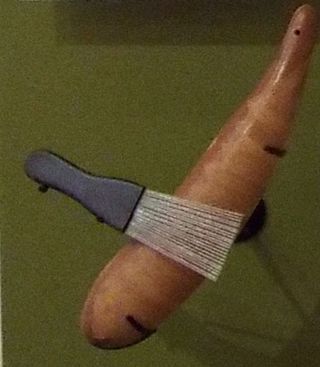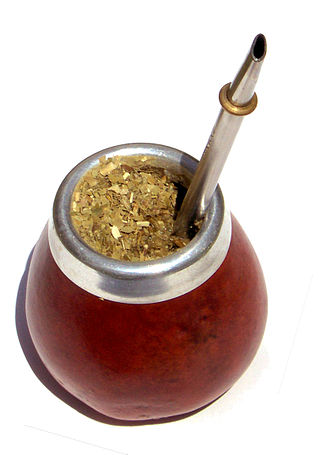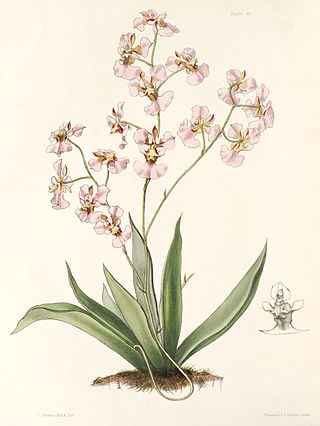
A tobacco pipe, often called simply a pipe, is a device specifically made to smoke tobacco. It comprises a chamber for the tobacco from which a thin hollow stem (shank) emerges, ending in a mouthpiece. Pipes can range from very simple machine-made briar models to highly prized hand-made artisanal implements made by renowned pipemakers, which are often very expensive collector's items. Pipe smoking is the oldest known traditional form of tobacco smoking.

A maraca, sometimes called shaker or chac-chac, is a rattle which appears in many genres of Caribbean and Latin music. It is shaken by a handle and usually played as part of a pair.

The güiro is a percussion instrument consisting of an open-ended, hollow gourd with parallel notches cut in one side. It is played by rubbing a stick or tines along the notches to produce a ratchet sound.

Gourds include the fruits of some flowering plant species in the family Cucurbitaceae, particularly Cucurbita and Lagenaria. The term refers to a number of species and subspecies, many with hard shells, and some without. One of the earliest domesticated types of plants, subspecies of the bottle gourd, Lagenaria siceraria, have been discovered in archaeological sites dating from as early as 13,000 BCE. Gourds have had numerous uses throughout history, including as tools, musical instruments, objects of art, film, and food.

Yerba mate or yerba-maté is a plant species of the holly genus Ilex native to South America. It was named by the French botanist Augustin Saint-Hilaire. The leaves of the plant can be steeped in hot water to make a beverage known as mate. Brewed cold, it is used to make tereré. Both the plant and the beverage contain caffeine.

The berimbau is a traditional Angolan musical bow that is commonly used in Brazil. It is also known as Sekitulege among the Baganda and Busoga.

Calabash, also known as bottle gourd, white-flowered gourd, long melon, birdhouse gourd, New Guinea bean, New Guinea butter bean, Tasmania bean, and opo squash, is a vine grown for its fruit. It can be either harvested young to be consumed as a vegetable, or harvested mature to be dried and used as a utensil, container, or a musical instrument. When it is fresh, the fruit has a light green smooth skin and white flesh.

Cauliflory is a botanical term referring to plants that flower and fruit from their main stems or woody trunks, rather than from new growth and shoots. It is rare in temperate regions but common in tropical forests.

Crescentia is a genus of six species of flowering plants in the family Bignoniaceae, native to southern North America, the Caribbean, Central America northern South America. The species are moderate-size trees growing to 10 m (35 ft) tall, and producing large spherical fruits, with a thin, hard shell and soft pulp, up to 25 cm (10 in) in diameter.

Spondias purpura is a species of flowering plant in the cashew family, Anacardiaceae, that is native to tropical regions of the Americas, from Mexico to northern Colombia and the southwest Caribbean Islands. It has also been introduced to and naturalized to other parts of the American tropics, Southeast Asia, and West Africa. It is commonly known as jocote, which derives from the Nahuatl word xocotl, meaning any kind of sour or acidic fruit. Other common names include red mombin, Spanish plum, purple mombin, Jamaica plum, and hog plum.

Crescentia alata, variously called Mexican calabash, jícaro, morro, morrito, or winged calabash, is a plant species in the family Bignoniaceae and in the genus Crescentia, native to southern Mexico and Central America south to Costa Rica.

Mate or maté is a traditional South American caffeine-rich infused herbal drink. It is also known as chimarrão or cimarrón, and ka’ay in Guarani. It is made by soaking dried yerba mate leaves in hot water and is traditionally served with a metal straw in a container typically made from a calabash gourd, but also made from a cattle horn in some areas. A very similar preparation, known as mate cocido, removes some of the plant material and sometimes comes in tea bags. Today, mate is sold commercially in tea bags and as bottled iced tea.

The Jardin de l'État, formerly known as the Jardin du Roy, is a historic botanical garden on the island of Réunion, found in the capital Saint-Denis.

Tolumnia variegata, commonly known as the harlequin dancing-lady orchid or variegated oncidium in English and as angelito or angelitos in Spanish, is a species of orchid native to the Caribbean.

Mexican lacquerware is one of the country's oldest crafts, having independent origins from Asian lacquerware. In the pre-Hispanic period, a greasy substance from the aje larvae and/or oil from the chia seed were mixed with powdered minerals to create protective coatings and decorative designs. During this period, the process was almost always applied to dried gourds, especially to make the cups that Mesoamerican nobility drank chocolate from. After the Conquest, the Spanish had indigenous craftsmen apply the technique to European style furniture and other items, changing the decorative motifs and color schemes, but the process and materials remained mostly the same. In the 19th and 20th centuries, the craft waned during armed conflicts and returned, both times with changes to the decorative styles and especially in the 20th century, to production techniques. Today, workshops creating these works are limited to Olinalá, Temalacatzingo and Acapetlahuaya in the state of Guerrero, Uruapan and Pátzcuaro in Michoacán and Chiapa de Corzo in Chiapas.
ʻUlīʻulī are Hawaiian feathered gourd rattles that are occasionally used as instruments in the traditional Hawaiian dance, hula. This instrument is used in both ʻauana and kahiko hula dances. They are vibrantly colored feather gourd rattles used in kahiko performances to maintain timing and to enhance other sounds like chanting or the pounding of an ipu.

The olinalá is a lacquering technique native to Olinalá, Guerrero, Mexico. To make objects with olinalá, the aromatic wood extracted from the linaloe tree is highly appreciated. It grows naturally in the region. The art of olinalá is closely associated with the indigenous communities of the area, mainly speaking Nahuatl and Tlapanec.

Mate burilado are calabash or gourd fruit decorated by hand with a technique called burilado using the carving instrument called buril or burin. This Peruvian folk art form is found in the Mantaro Valley, as well as in the provinces of Lambayeque and Huanta. For more than 4,000 years, artisans have practiced the tradition of hand-carving dried gourds to document oral narratives. Commonly, the training process takes five years.

Calabash is a traditional plant locally grown in many parts of Uganda. Its a non-food plant that produces several fruits of different sizes. The biological name of this plant is Lagenaria siceraria. Once harvested, its left to dry and is mainly used for traditional purpurses like dancing during traditional weddings, crafted as musical instruments by some tribes in their traditional dances for example the Bigwala, Baganda, Acholi, preserving milk, harvesting milk cream, and also used by traditional healers. Calabash is a symbolic cultural item that many Ugandan tribes use for different purposes.























